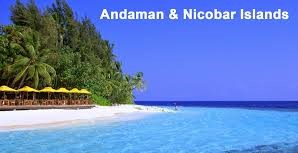In our previous blog, we had a great discussion over some of the aspects of the Andaman and Nicobar Islands. If you’ve missed out on it click here for Know your state ‘Andaman and Nicobar Islands’ (Part1). Now further we will talk about other important aspects that are history, environment and economy of the islands.
What are the environmental aspects of the Andaman and Nicobar Islands? Where is the largest land-living arthropod in the world found?
Now without any further ado, let’s get started with the first aspect i.e. History of Andaman and Nicobar Islands.
Table of Contents
HISTORY Andaman and Nicobar Islands GK Notes:
The history of Andaman and Nicobar Islands is still a mystery to many. No one actually knows when and how the first inhabitants came to this island. The earliest pale-history evidence yet documented goes back some 2,200 years.
- The name Andaman is derived from the name of the monkey god of Hindu mythology “Hanuman”. The name Nicobar is derived from the Tamil word “nakkavaram” which means the land of the naked.
- The first empire to list the islands under its territory was the Maratha Empire by Rajendra Chola, one of the Chola dynasty kings.
- The Danish settlers, Danish East India Company arrived at the Nicobar Islands on 12 December 1755. The Nicobar Islands were made a Danish colony and named New Denmark on 1 January 1756.
- In 1789, the British established their colony in Andaman and Nicobar Islands. But later on, the island was abandoned by the British in 1796. They resumed control over the island in the 19th century.
- The British used Andaman and Nicobar as a penal colony, which was named ‘‘Kala Pani” or the Cellular Jail.
- The criminals convicted of any crime against the East India Company were sent to Andaman and Nicobar Islands, with a life sentence that the convicts were forced to live in exile in the Kalapani.
- With the end of British rule, i.e. after the Indian Independence, the ‘Kalapani’ kicked away from the assortment of beautiful islands.
- In 1947, Andaman and Nicobar Islands became a part of India as one of the union territories.
Now, let’s switch to the environmental attribute of the union territory.
ENVIRONMENT Andaman and Nicobar Islands GK Notes:
Andaman and Nicobar Islands are the union territory of India at the south-eastern edge of the Bay of Bengal. The territory is blessed with a unique tropical rainforest, varieties of forest animals, exotic sea beaches etc.
- The recorded forest area of the UT is 7,170.69 sq. km which is 86.93% of its geographical area. The Reserved and Protected Forests are 78.27% and 21.73% respectively of the recorded forest area.
- Major Rivers in Andaman and Nicobar Islands are the Alexandra, Amrit Kaur, Danes, Galathea and Dogmar and each of them has its origin in the Mount Thullier.
- There are majorly two reservoirs namely Kalpong dam, Dhanikhari Dam.
- Total number of Wildlife Sanctuaries in Andaman and Nicobar Islands is 96.
- Total number of National Parks in Andaman and Nicobar Islands is 9.
- Mahatma Gandhi Marine National Park, Landfall Island Wildlife Sanctuary, Cuthbert Bay Wildlife Sanctuary, Mount Harriet National Park, Interview Island Wildlife Sanctuary, Saddle Peak National Park, Rutland Island, Lohabarrack Salt Water Crocodile Sanctuary, etc. are some famous wildlife sanctuaries and national parks in Andaman and Nicobar Islands.
Now it’s time to look over the economy of this union territory.
ECONOMY Andaman and Nicobar Islands GK Notes:
The economy of Andaman and Nicobar Islands consists of agriculture, trade, commerce, fishing and industry. Paddy is the main food crop and mostly cultivated in the Andaman group of islands, whereas Coconut and Areca nut are the cash crops of Nicobar group of islands. Tourism to the Andaman and Nicobar Islands is increasing due to the popularity of beaches and adventure sports like snorkeling and sea-walking. Indian tourists do not require a permit to visit the Andaman Islands. GDP of the islands is 0.079 lakh crore.
Here are some more interesting facts about ANDAMAN AND NICOBAR ISLANDS:
- Commercial fishing has been banned around the Andaman Islands for more than 4 decades.
- The Robber Crab (Birgus Latro), also called the Coconut Crab, is the largest land-living arthropod in the world. They generally live on land, but at night they climb up the coconut trees and carve a hole.
- Barren Island is the only active volcano not just in India but the whole of South Asia.
- Jal Hans is India’s first commercial seaplane which was launched in the Andaman Islands.
Therefore, this was all the chief necessitate information about Andaman and Nicobar Islands that will help in your preparation for competitive exams like SSC CGL, CDS, Civil Services and NDA etc.
If you wish to read about the other Island States of India, you can click on the links given below:
Know your State ‘Dadra and Nagar Haveli and Daman and Diu’
Know your State ‘Lakshadweep’
THANK YOU




